完整版文房四宝英文介绍
- 格式:ppt
- 大小:14.43 MB
- 文档页数:20
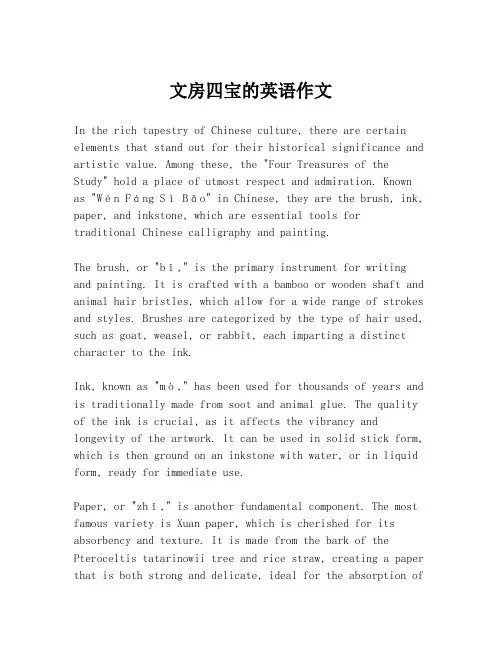
文房四宝的英语作文In the rich tapestry of Chinese culture, there are certain elements that stand out for their historical significance and artistic value. Among these, the "Four Treasures of the Study" hold a place of utmost respect and admiration. Known as "Wén Fáng Sì Bǎo" in Chinese, they are the brush, ink, paper, and inkstone, which are essential tools fortraditional Chinese calligraphy and painting.The brush, or "bǐ," is the primary instrument for writing and painting. It is crafted with a bamboo or wooden shaft and animal hair bristles, which allow for a wide range of strokes and styles. Brushes are categorized by the type of hair used, such as goat, weasel, or rabbit, each imparting a distinct character to the ink.Ink, known as "mò," has been used for thousands of years and is traditionally made from soot and animal glue. The quality of the ink is crucial, as it affects the vibrancy and longevity of the artwork. It can be used in solid stick form, which is then ground on an inkstone with water, or in liquid form, ready for immediate use.Paper, or "zhǐ," is another fundamental component. The most famous variety is Xuan paper, which is cherished for its absorbency and texture. It is made from the bark of the Pteroceltis tatarinowii tree and rice straw, creating a paper that is both strong and delicate, ideal for the absorption ofink without smudging.The inkstone, "yàn," is a flat, smooth stone, usually made from slate or ceramic, where the ink stick is ground with water to create liquid ink. It is not only a practical tool but also a piece of art, often carved with intricate designs and inscriptions.Together, these four treasures form the backbone oftraditional Chinese calligraphy and painting, which are considered not just arts but also a form of spiritual practice and personal cultivation. The act of creating with these tools requires patience, discipline, and a deep connection with the materials, reflecting the harmony between humanity and nature.In conclusion, the Four Treasures of the Study are more than just tools; they are symbols of China's profound cultural heritage. They represent the intersection of utility, artistry, and philosophy, and continue to inspire artists and connoisseurs alike in the modern age.。
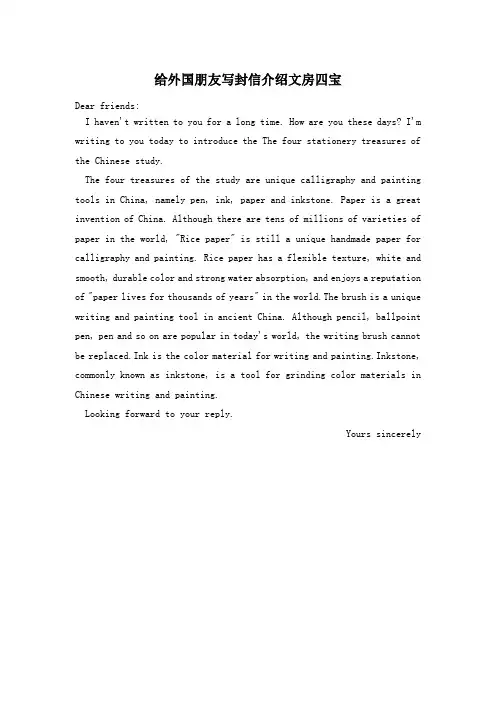
给外国朋友写封信介绍文房四宝Dear friends:I haven't written to you for a long time. How are you these days? I'm writing to you today to introduce the The four stationery treasures of the Chinese study.The four treasures of the study are unique calligraphy and painting tools in China, namely pen, ink, paper and inkstone. Paper is a great invention of China. Although there are tens of millions of varieties of paper in the world, "Rice paper" is still a unique handmade paper for calligraphy and painting. Rice paper has a flexible texture, white and smooth, durable color and strong water absorption, and enjoys a reputation of "paper lives for thousands of years" in the world.The brush is a unique writing and painting tool in ancient China. Although pencil, ballpoint pen, pen and so on are popular in today's world, the writing brush cannot be replaced.Ink is the color material for writing and painting.Inkstone, commonly known as inkstone, is a tool for grinding color materials in Chinese writing and painting.Looking forward to your reply.Yours sincerely。
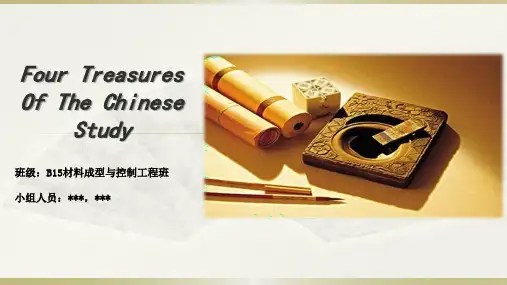
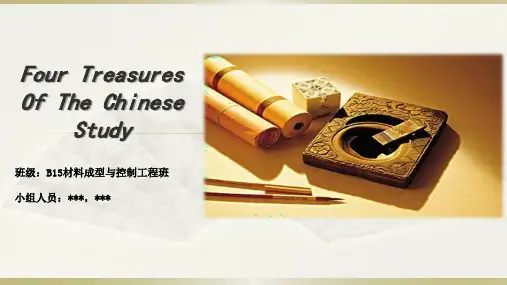


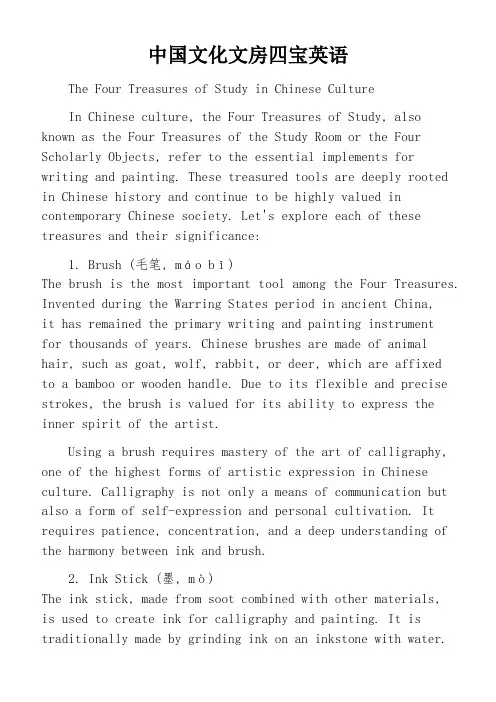
中国文化文房四宝英语The Four Treasures of Study in Chinese CultureIn Chinese culture, the Four Treasures of Study, also known as the Four Treasures of the Study Room or the Four Scholarly Objects, refer to the essential implements forwriting and painting. These treasured tools are deeply rooted in Chinese history and continue to be highly valued in contemporary Chinese society. Let's explore each of these treasures and their significance:1. Brush (毛笔, máo bǐ)The brush is the most important tool among the Four Treasures. Invented during the Warring States period in ancient China,it has remained the primary writing and painting instrumentfor thousands of years. Chinese brushes are made of animal hair, such as goat, wolf, rabbit, or deer, which are affixedto a bamboo or wooden handle. Due to its flexible and precise strokes, the brush is valued for its ability to express the inner spirit of the artist.Using a brush requires mastery of the art of calligraphy, one of the highest forms of artistic expression in Chinese culture. Calligraphy is not only a means of communication but also a form of self-expression and personal cultivation. It requires patience, concentration, and a deep understanding of the harmony between ink and brush.2. Ink Stick (墨, mò)The ink stick, made from soot combined with other materials,is used to create ink for calligraphy and painting. It is traditionally made by grinding ink on an inkstone with water.The process of grinding the ink stick against the inkstone is seen as an essential artistic practice, allowing the artistto reflect on self-discipline and self-control.Ink sticks come in various colors and qualities, offering different shades and consistencies of ink. The type of ink used affects the final outcome of the artwork, emphasizingthe importance of selecting the appropriate ink for different artistic purposes.3. Paper (宣纸, xuān zhǐ)Xuan paper, also known as rice paper, is the preferredmaterial for writing and painting in traditional Chinese culture. Originating from ancient Xuanzhou in today's Anhui province, Xuan paper is made from the bark of the tan tree.It is known for its smooth texture, durability, and abilityto absorb ink effectively, allowing the brush strokes to appear vividly on the paper.Xuan paper embodies the desire for transcendence, purity, and spiritual tranquility. It represents the harmony between humans and nature, as it is made from natural materials and contributes to the expression of artistic beauty.4. Inkstone (砚台, yàn tái)The inkstone is used to hold and grind the ink stick into ink. It is typically made of stone, such as slate or inkstone,which has a smooth and flat grinding surface. The process of using an inkstone requires the artist to hold the ink stickat a specific angle and grind it with circular motions until the desired consistency of ink is achieved.The inkstone represents perseverance, as the artist must exert effort and patience to create the perfect ink. It alsosymbolizes stability, as the inkstone remains unchanged over time, mirroring the Confucian values of constancy andintegrity.In conclusion, the Four Treasures of Study in Chinese culture represent the essence of traditional Chinese painting and calligraphy. The brush, ink stick, paper, and inkstoneare not just tools but bear profound symbolic meanings. They embody the values of self-expression, discipline, cultivation, and harmony with nature. These treasures continue to inspire and be cherished by artists, scholars, and enthusiasts alike, serving as a link between the ancient traditions and modern Chinese society.。

模拟高考类介绍文房四宝的英语80词作文全文共3篇示例,供读者参考篇1The Four Treasures of the Study, also known as Wenfang Sibao, are essential tools for Chinese calligraphy and painting. These four treasures include the brush, ink, paper, and inkstone. They are not only tools but also symbols of Chinese culture and tradition.The brush, or bi, is made of animal hair, such as rabbit, wolf, or weasel, and attached to a bamboo stick. The bristles need to be soft and resilient to effectively absorb and release ink. The brush is a versatile tool that can create thick or thin strokes, and it plays a crucial role in calligraphy and painting.Ink, or mo, is traditionally made from pine soot and animal glue. Ink is ground on an inkstone with water to create a smooth and consistent texture. Different shades of ink can be obtained by adjusting the amount of water added. The ink is an integral part of Chinese calligraphy, and it symbolizes the essence and spirit of the artist.Paper, or zhi, is typically made from mulberry tree bark, bamboo, or rice straw. Chinese calligraphy paper is thin, strong, and absorbent, allowing the ink to flow smoothly and evenly. The quality of paper affects the final outcome of calligraphy and painting.The inkstone, or yan, is a flat stone slab used for grinding ink. It is often carved with intricate designs or poetry, adding an aesthetic element to the writing process. The inkstone is a symbol of wisdom and patience, as it requires skill and time to grind the ink properly.In conclusion, the Four Treasures of the Study are not just tools but also symbols of Chinese art and culture. They require skill, patience, and dedication to use effectively, and they are cherished by calligraphers and artists around the world.篇2Introduction to the Four Treasures of StudyThe Four Treasures of Study, also known as Wenfang Sibao in Chinese, refer to the essential tools used for traditional Chinese calligraphy and painting. These four treasures are the brush, ink stick, inkstone, and paper. Each treasure plays a vital role in the creation of traditional Chinese artworks.The brush, called the "bi" in Chinese, is made from animal hair such as goat, rabbit, or wolf. It comes in various sizes and shapes, each suitable for different styles of calligraphy and painting. The brush is the most important tool in Chinese art, as it allows artists to create strokes of varying thickness and texture.The ink stick, or "mo" in Chinese, is made from soot and animal glue. It is ground on an inkstone with water to create ink for painting and calligraphy. The quality of the ink depends on the texture and smoothness of the ink stick, as well as the skill of the artist in grinding the ink.The inkstone, or "yan" in Chinese, is used to grind the ink stick and water together to create ink. It is usually made from stone, ceramic, or clay, and comes in various sizes and shapes. The inkstone is an essential tool for artists, as it determines the quality and consistency of the ink used in artworks.The paper, or "zhi" in Chinese, is made from various materials such as bamboo, rice straw, or mulberry bark. Traditional Chinese paper is thin, absorbent, and durable, making it ideal for calligraphy and painting. Artists choose different types of paper based on the specific needs of their artwork.In conclusion, the Four Treasures of Study are indispensable tools for traditional Chinese calligraphy and painting. These treasures have been used for centuries by artists to create beautiful and expressive artworks. The brush, ink stick, inkstone, and paper each play a unique role in the artistic process, making them essential items for any aspiring artist.篇3Nowadays, with the advent of modern technology, many traditional Chinese cultural practices are gradually being replaced by more convenient alternatives. However, there are still some traditions that hold a special place in the hearts of many Chinese people. One such tradition is the use of the four treasures of the study, also known as the "wenfang si bao".The four treasures of the study are essential tools for any scholar or calligrapher, and they have been a symbol of knowledge and creativity for centuries. These treasures include the brush, the ink stick, the ink stone, and the paper. Each of these items plays a unique role in the process of writing or painting, and together they form a harmonious balance that allows the artist to express themselves fully.The brush, or "bi", is perhaps the most important of the four treasures. Made from various materials such as animal hair or plant fibers, the brush is used to create intricate Chinese calligraphy and paintings. The ink stick, or "mo", is used to create the ink that is applied to the brush. The ink stick is made from a mixture of charcoal and other ingredients, and it is ground against the ink stone, or "yan", to create a smooth and consistent ink.The ink stone is a flat, rectangular surface that is used to grind the ink stick and mix it with water to create the perfect consistency for writing or painting. Finally, the paper, or "zhi", is the surface on which the artist works. Traditional Chinese paper is made from bamboo or mulberry fibers, and it has a unique texture that allows the ink to flow smoothly and evenly.In conclusion, the four treasures of the study are not just tools for writing or painting, but symbols of Chinese culture and tradition. They represent the harmony between nature and creativity, and they inspire artists and scholars to express themselves in new and meaningful ways. So, next time you pick up a brush to write or paint, remember the ancient tradition of the wenfang si bao, and let the spirit of the four treasures guide your hand.。
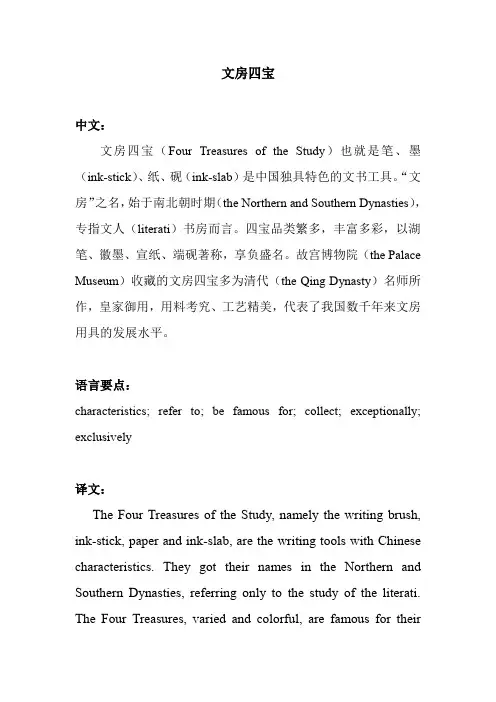
文房四宝中文:文房四宝(Four Treasures of the Study)也就是笔、墨(ink-stick)、纸、砚(ink-slab)是中国独具特色的文书工具。
“文房”之名,始于南北朝时期(the Northern and Southern Dynasties),专指文人(literati)书房而言。
四宝品类繁多,丰富多彩,以湖笔、徽墨、宣纸、端砚著称,享负盛名。
故宫博物院(the Palace Museum)收藏的文房四宝多为清代(the Qing Dynasty)名师所作,皇家御用,用料考究、工艺精美,代表了我国数千年来文房用具的发展水平。
语言要点:characteristics; refer to; be famous for; collect; exceptionally; exclusively译文:The Four Treasures of the Study, namely the writing brush, ink-stick, paper and ink-slab, are the writing tools with Chinese characteristics. They got their names in the Northern and Southern Dynasties, referring only to the study of the literati. The Four Treasures, varied and colorful, are famous for theirhubi, huimo, xuanzhi, and duanyan. Those collected in the Palace Museum are famous products of masters of the Qing Dynasty, which, boasting exceptionally fine materials and superb craftsmanship, were used exclusively in the Royal Palace, representing the level of development of Chinese writing tools over several thousand years.。
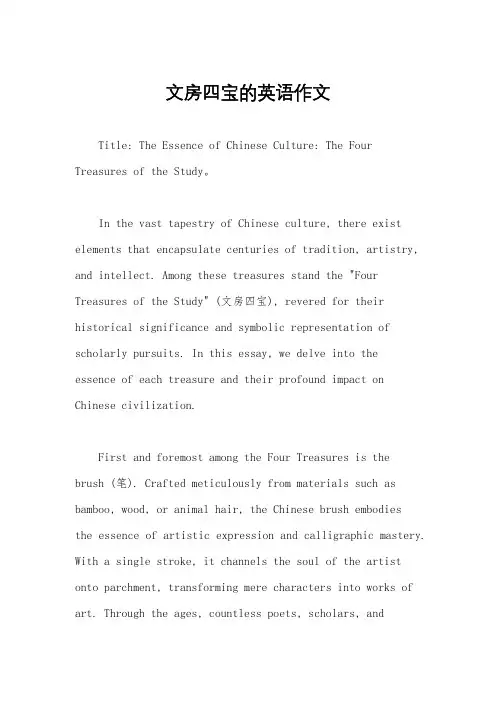
文房四宝的英语作文Title: The Essence of Chinese Culture: The Four Treasures of the Study。
In the vast tapestry of Chinese culture, there exist elements that encapsulate centuries of tradition, artistry, and intellect. Among these treasures stand the "Four Treasures of the Study" (文房四宝), revered for their historical significance and symbolic representation of scholarly pursuits. In this essay, we delve into the essence of each treasure and their profound impact on Chinese civilization.First and foremost among the Four Treasures is thebrush (笔). Crafted meticulously from materials such as bamboo, wood, or animal hair, the Chinese brush embodiesthe essence of artistic expression and calligraphic mastery. With a single stroke, it channels the soul of the artist onto parchment, transforming mere characters into works of art. Through the ages, countless poets, scholars, andartisans have wielded this instrument to immortalize their thoughts and emotions, leaving an indelible mark on Chinese literature and aesthetics.Accompanying the brush is ink (墨), the lifeblood of traditional Chinese writing. Derived from soot, resin, and water, ink embodies the essence of simplicity and profundity. When applied with skillful precision, it flows gracefully across paper, giving birth to intricate characters and vibrant landscapes. Yet, beyond its utilitarian function, ink symbolizes the enduring nature of knowledge and the boundless depths of human imagination. From the elegant scrolls of ancient scholars to the meticulous paintings of contemporary artists, ink remains a timeless medium through which culture and creativity converge.Complementing the brush and ink are paper (纸) and inkstone (砚), indispensable tools that complete the quartet of treasures. Paper, invented by the Chinese during the Han Dynasty, revolutionized the dissemination of knowledge and facilitated the flourishing of literature andscholarship. Its versatility and durability have made it a cornerstone of Chinese civilization, preserving the wisdom of sages and the dreams of poets for generations to come. Similarly, the inkstone, with its smooth surface and reservoir for ink, serves as both a practical tool and a symbol of scholarly discipline. As scholars grind ink upon its surface with meticulous care, they pay homage to the timeless traditions of learning and cultivation.Together, the Four Treasures of the Study represent more than mere tools of the trade; they embody the essence of Chinese culture itself. Through their mastery, scholars have transcended the confines of time and space, imparting wisdom and beauty to successive generations. From the graceful strokes of calligraphy to the vibrant hues of traditional painting, these treasures serve as a testament to the enduring spirit of human creativity and intellect.In conclusion, the Four Treasures of the Study stand as an enduring testament to the rich heritage of Chinese civilization. Through the brush, ink, paper, and inkstone, scholars have shaped the course of history, leaving anindelible mark on the cultural landscape of the world. As we contemplate their significance, let us not merely admire their beauty, but also reflect on the profound wisdom and timeless truths they represent. For in the delicate strokes of a calligrapher's hand and the vibrant hues of anartist's palette, we glimpse the essence of human experience and the boundless potential of the human spirit.。
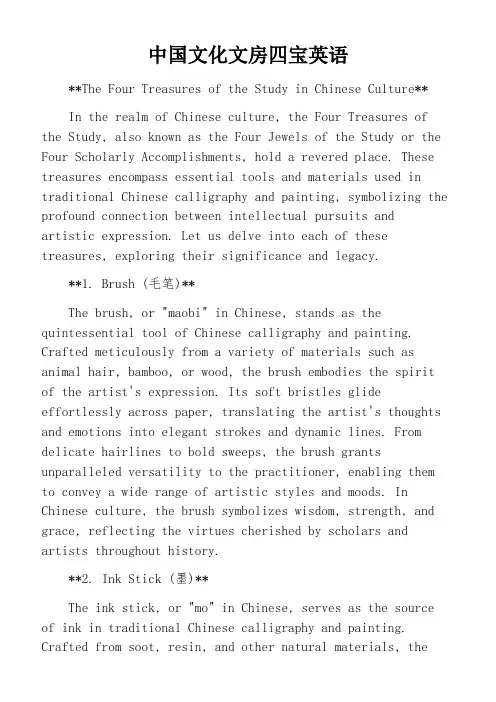
中国文化文房四宝英语**The Four Treasures of the Study in Chinese Culture**In the realm of Chinese culture, the Four Treasures of the Study, also known as the Four Jewels of the Study or the Four Scholarly Accomplishments, hold a revered place. These treasures encompass essential tools and materials used in traditional Chinese calligraphy and painting, symbolizing the profound connection between intellectual pursuits andartistic expression. Let us delve into each of these treasures, exploring their significance and legacy.**1. Brush (毛笔)**The brush, or "maobi" in Chinese, stands as the quintessential tool of Chinese calligraphy and painting. Crafted meticulously from a variety of materials such as animal hair, bamboo, or wood, the brush embodies the spirit of the artist's expression. Its soft bristles glide effortlessly across paper, translating the artist's thoughts and emotions into elegant strokes and dynamic lines. From delicate hairlines to bold sweeps, the brush grants unparalleled versatility to the practitioner, enabling them to convey a wide range of artistic styles and moods. In Chinese culture, the brush symbolizes wisdom, strength, and grace, reflecting the virtues cherished by scholars and artists throughout history.**2. Ink Stick (墨)**The ink stick, or "mo" in Chinese, serves as the source of ink in traditional Chinese calligraphy and painting. Crafted from soot, resin, and other natural materials, theink stick undergoes a meticulous process of grinding and mixing to produce a smooth, rich ink. Symbolizing the essence of creativity and depth, ink embodies the artist's spirit and imagination, flowing freely from the brush onto paper. The act of grinding ink is not merely a preparatory step but a ritualistic practice, fostering a deep connection between the artist and their craft. In Chinese culture, the ink stick represents integrity, perseverance, and the transformative power of artistry.**3. Paper (宣纸)**Paper, or "xuanzhi" in Chinese, serves as the canvas for calligraphy and painting, providing a surface for the artist to express their vision. Renowned for its absorbency, durability, and smooth texture, xuan paper is crafted from the bark of the sandalwood tree, meticulously processed to achieve its distinctive qualities. Each sheet of papercarries a history of craftsmanship, embodying the centuries-old traditions of Chinese artistry. From the delicate fibers to the subtle sheen, xuan paper enhances the beauty and authenticity of the artist's work, inviting viewers to immerse themselves in its timeless elegance. In Chinese culture, paper symbolizes purity, resilience, and the boundless potential of creativity.**4. Ink Stone (砚台)**The ink stone, or "yantai" in Chinese, serves as the vessel for grinding ink, embodying the harmony between nature and artifice. Carved from stone or ceramic, the ink stone features a smooth surface where ink is ground with water to create the desired consistency. The act of grinding ink onthe stone is a meditative practice, requiring patience, precision, and a deep appreciation for the transformative power of the creative process. As the ink stone absorbs the traces of ink over time, it becomes imbued with the artist's spirit, bearing witness to their journey of exploration and discovery. In Chinese culture, the ink stone symbolizes wisdom, resilience, and the enduring legacy of artistic tradition.In conclusion, the Four Treasures of the Study represent more than mere tools; they embody the essence of Chinese culture, serving as a testament to the enduring power of creativity, intellect, and expression. From the delicate strokes of the brush to the rich hues of ink, these treasures continue to inspire generations of artists and scholars, fostering a deep appreciation for the beauty and complexity of the human experience.。
中英对照原文文房四宝Four Treasures of Study现在我们来谈谈中国画作画时常用的工具。
Now let’s talk about the things, or the tools we are gonna use to paint Chinese painting.我们把这些工具称作“文房四宝”,意思就是书房里的四件宝物。
In Chinese we called those tools as “Wen Fang Si Bao”, literally means the four treasures in your study.这些是毛笔,我们叫做“笔”。
These are the brushes; we call it “Bi”.这是“墨”。
And this is ink.这是“纸”。
And this is of course paper, you can see that.这块石头是“砚”,叫做砚石或砚台。
And this piece of stone we call it ink stone or ink slab.这件我们叫做“笔”的东西,在英语中叫做“刷子”。
The thing is that, this is called “Bi” in Chinese. But of course I see that in English it’s called brush.在西方绘画中,你们用扁平的刷子,但在中国绘画和书法中,我们用圆形的刷子。
In western painting, you use a kind of a flat brush, but in Chinese painting or Chinese calligraphy, we use a round one. 在中文中我们说的笔,听起来与英文中的,“钢笔”是一样的。
And in Chinese we call it “Bi”, which sounds very much like or exactly the same as we would call it pen in English.所以这是很传统的“中国笔”。
文房四宝的英语作文In China, there are four treasures of the study, including the brush, ink stick, ink slab, and paper. These four items are essential for traditional Chinesecalligraphy and painting.The brush is usually made of animal hair, such as goat, rabbit, or wolf, and the handle is made of bamboo, wood, or other materials. It is used for writing Chinese characters and creating beautiful brush paintings.The ink stick is made from soot and animal glue, which are mixed together and then molded into a stick shape. To use the ink stick, it needs to be ground on an ink slab with a little water until the ink becomes thick and smooth.The ink slab is a flat surface, usually made of stone, on which the ink stick is ground. It is often carved with decorative patterns and inscriptions, making it not only a practical tool but also a work of art.The paper used for calligraphy and painting is called Xuan paper, which is made from the bark of the sandalwood tree. It is smooth, durable, and absorbent, making it perfect for capturing the subtle nuances of brushwork and ink.These four treasures of the study are not only tools for artistic creation but also symbols of Chinese culture and tradition. They have been cherished by scholars and artists for centuries, and continue to inspire creativity and appreciation for the beauty of Chinese calligraphy and painting.。
中国文化文房四宝英语The Four Treasures of the Study, which are also known as the Four Gentlemen, represent the essential tools used in traditional Chinese calligraphy and painting. These treasures consist of the brush, ink stick, paper, and ink stone. They have played a significant role in the development and preservation of Chinese culture throughout history.The first treasure is the brush, or "bi" in Chinese. Itis usually made of animal hair, such as wolf, sheep, or rabbit, which is glued to a bamboo or wooden handle. The quality of the brush determines the artist's stroke and the overall effect of the artwork. Different brushes are used for different purposes and styles, such as the pointed brush for precise and intricate lines, and the flat brush for bold and expressive strokes. The brush is not only a tool but also a symbol of the artist's skill and creativity.The second treasure is the ink stick, or "mo" in Chinese. It is made by grinding inkstick on an inkstone with water. The ink is derived from various materials, including pine soot, oil soot, and charcoal. The ink sticks are typically wrapped in silk or decorated with beautiful patterns or calligraphy. The ink's quality is crucial in creating different shades and textures in calligraphy and painting. The ink's fragrance and color are also appreciated by artists and connoisseurs.The third treasure is the paper, or "zhi" in Chinese. Traditional Chinese paper is made from materials such as rice straw, bamboo, mulberry bark, or hemp. Each type of paper has its own texture, thickness, and absorbency, which affects thefinal appearance of the artwork. Mulberry paper isparticularly popular for calligraphy and painting due to its durability and ability to hold ink well. Chinese paper is known for its softness and flexibility, allowing artists to control their brush strokes more precisely.The fourth treasure is the inkstone, or "yan" in Chinese. It is made of special stones, such as slate, porphyry, or inkstone rock. The inkstone has an indentation called the inkwell, where the inkstick is ground with water to create liquid ink. Some inkstones have intricate carvings or patterns, and they are often considered collectible works of art. The inkstone's smooth surface and proper texture are crucial for grinding the ink into the right consistency and achieving the desired richness of color.These Four Treasures of the Study are not only tools but also cultural symbols. They represent the wisdom, elegance, and discipline of Chinese intellectuals and artists. They have been passed down for centuries, encompassing the essence of traditional Chinese calligraphy and painting. They continue to be revered and used by artists, calligraphers, and enthusiasts around the world who appreciate the beauty and depth of Chinese culture.In conclusion, the Four Treasures of the Study – the brush, ink stick, paper, and ink stone – hold immense importance in Chinese culture. They are not only tools but also symbols of artistic expression and traditional craftsmanship. These treasures showcase the profound connection between calligraphy, painting, and Chineseheritage. Their continued use and preservation highlight the enduring influence of Chinese culture in the world of art.。